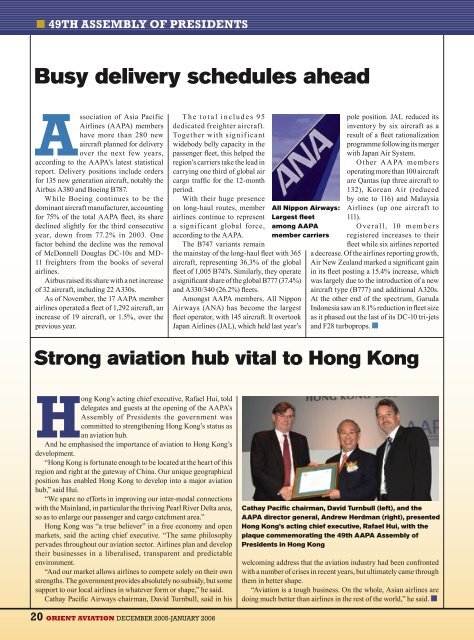You also want an ePaper? Increase the reach of your titles
YUMPU automatically turns print PDFs into web optimized ePapers that Google loves.
49TH ASSEMBLY OF PRESIDENTS<br />
Busy delivery schedules ahead<br />
Association of Asia Pacific<br />
Airlines (AAPA) members<br />
have more than 280 new<br />
aircraft planned for delivery<br />
over the next few years,<br />
according to the AAPA’s latest statistical<br />
report. Delivery positions include orders<br />
for 135 new generation aircraft, notably the<br />
Airbus A380 and Boeing B787.<br />
While Boeing continues to be the<br />
dominant aircraft manufacturer, accounting<br />
for 75% of the total AAPA fleet, its share<br />
declined slightly for the third consecutive<br />
year, down from 77.2% in 2003. One<br />
factor behind the decline was the removal<br />
of McDonnell Douglas DC-10s and MD-<br />
11 freighters from the books of several<br />
airlines.<br />
Airbus raised its share with a net increase<br />
of 32 aircraft, including 22 A330s.<br />
As of November, the 17 AAPA member<br />
airlines operated a fleet of 1,292 aircraft, an<br />
increase of 19 aircraft, or 1.5%, over the<br />
previous year.<br />
T h e t o t a l i n c l u d e s 9 5<br />
dedicated freighter aircraft.<br />
Together with signif icant<br />
widebody belly capacity in the<br />
passenger fleet, this helped the<br />
region’s carriers take the lead in<br />
carrying one third of global air<br />
cargo traffic for the 12-month<br />
period.<br />
With their huge presence<br />
on long-haul routes, member<br />
airlines continue to represent<br />
a significant global force,<br />
according to the AAPA.<br />
The B747 variants remain<br />
the mainstay of the long-haul fleet with 365<br />
aircraft, representing 36.3% of the global<br />
fleet of 1,005 B747s. Similarly, they operate<br />
a significant share of the global B777 (37.4%)<br />
and A330/340 (26.2%) fleets.<br />
Amongst AAPA members, All Nippon<br />
Airways (ANA) has become the largest<br />
fleet operator, with 145 aircraft. It overtook<br />
Japan Airlines (JAL), which held last year’s<br />
All Nippon Airways:<br />
Largest fleet<br />
among AAPA<br />
member carriers<br />
pole position. JAL reduced its<br />
inventory by six aircraft as a<br />
result of a fleet rationalization<br />
programme following its merger<br />
with Japan Air System.<br />
Other A A PA members<br />
operating more than 100 aircraft<br />
are Qantas (up three aircraft to<br />
132), Korean Air (reduced<br />
by one to 116) and Malaysia<br />
Airlines (up one aircraft to<br />
111).<br />
O ve r a l l, 10 memb e r s<br />
registered increases to their<br />
fleet while six airlines reported<br />
a decrease. Of the airlines reporting growth,<br />
Air New Zealand marked a significant gain<br />
in its fleet posting a 15.4% increase, which<br />
was largely due to the introduction of a new<br />
aircraft type (B777) and additional A320s.<br />
At the other end of the spectrum, Garuda<br />
Indonesia saw an 8.1% reduction in fleet size<br />
as it phased out the last of its DC-10 tri-jets<br />
and F28 turboprops.<br />
Strong aviation hub vital to Hong Kong<br />
Hong Kong’s acting chief executive, Rafael Hui, told<br />
delegates and guests at the opening of the AAPA’s<br />
Assembly of Presidents the government was<br />
committed to strengthening Hong Kong’s status as<br />
an aviation hub.<br />
And he emphasised the importance of aviation to Hong Kong’s<br />
development.<br />
“Hong Kong is fortunate enough to be located at the heart of this<br />
region and right at the gateway of China. Our unique geographical<br />
position has enabled Hong Kong to develop into a major aviation<br />
hub,” said Hui.<br />
“We spare no efforts in improving our inter-modal connections<br />
with the Mainland, in particular the thriving Pearl River Delta area,<br />
so as to enlarge our passenger and cargo catchment area.”<br />
Hong Kong was “a true believer” in a free economy and open<br />
markets, said the acting chief executive. “The same philosophy<br />
pervades throughout our aviation sector. Airlines plan and develop<br />
their businesses in a liberalised, transparent and predictable<br />
environment.<br />
“And our market allows airlines to compete solely on their own<br />
strengths. The government provides absolutely no subsidy, but some<br />
support to our local airlines in whatever form or shape,” he said.<br />
Cathay Pacific Airways chairman, David Turnbull, said in his<br />
Cathay Pacific chairman, David Turnbull (left), and the<br />
AAPA director general, Andrew Herdman (right), presented<br />
Hong Kong’s acting chief executive, Rafael Hui, with the<br />
plaque commemorating the 49th AAPA Assembly of<br />
Presidents in Hong Kong<br />
welcoming address that the aviation industry had been confronted<br />
with a number of crises in recent years, but ultimately came through<br />
them in better shape.<br />
“<strong>Aviation</strong> is a tough business. On the whole, Asian airlines are<br />
doing much better than airlines in the rest of the world,” he said.<br />
20 ORIENT AVIATION DECEMBER 2005-JANUARY 2006








![OAMag-V7N4-Cover [Converted] - Orient Aviation](https://img.yumpu.com/48598575/1/190x255/oamag-v7n4-cover-converted-orient-aviation.jpg?quality=85)








